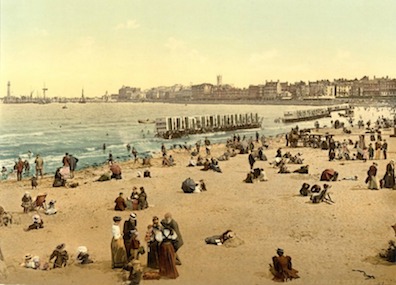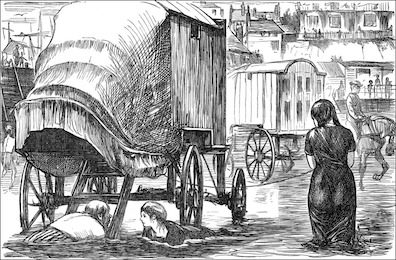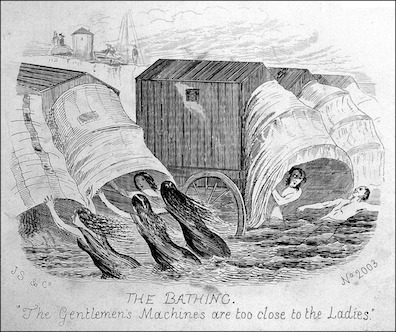Margate strand
Margate strand
In Brief
In Penelope Molly thinks of the beach where "Those Lovely Seaside Girls" is set: "those fine young men I could see down in Margate strand bathingplace from the side of the rock standing up in the sun naked like a God or something and then plunging into the sea with them why arent all men like that thered be some consolation for a woman." Margate is a seacoast town in Kent, in southeastern England. Victorians and Edwardians were preoccupied with what Bloom in Eumaeus calls "Margate with mixed bathing": a beach notorious for the close proximity of male and female swimmers, for displays of male nudity and revealing female attire, and for voyeurship both male and female.
Read More
When Molly thinks of "the side of the rock" she may be referring to one of the pools created by erosion in cliff walls near Margate. But the crowded "strand" had its own opportunities for women to gaze on nude men. The Victorians believed, in theory, that men and women should bathe apart from one another to avoid the arousal that might (ahem) arise from seeing members of the opposite sex without much clothing on. English beaches that had been developed for tourism had horse-drawn "bathing machines" that enabled people to enter fully clothed on the beach, change into their swimwear while the vehicle was being pushed out into the waves, and then discreetly enter the water down some back steps that were covered with fabric, preventing any viewing of exposed skin and clingy garments. On many such beaches, the men's and women's bathing machines were kept far apart, and swimmers were expected to frolic with members of their own gender while in the water. Violations of this expectation were referred to as "promiscuous bathing."
Margate possessed a reputation for very promiscuous bathing and for voyeurism, both of them aided by the fact that men's and women's bathing machines were not separated by any appreciable distance from each other or from the shore, as the photograph reproduced here illustrates. It also developed a reputation for tolerating male nudity. Mimi Matthews observes on her weblog, mimimatthews.com, that some gentlemen "emerged from their bathing machines in what the 2 September 1854 edition of the Leeds Times describes as an 'entirely primitive state.' Once in the water, these naked gentlemen had no compunction about approaching the female bathers nearby."
The chats and splashing contests that ensued attracted audiences on the beach, "some of whom employed telescopes to get a better view of the indecency. During the 1854 incident with the naked gentlemen, the Leeds Times reports that 'The beach was thronged with admiring spectators, and many of them with glasses, although they were not required, as the bathers, from the high tide, were close to the shore.” As in the 1850s, Matthews notes, "the crowds at Margate during the 1860s often used telescopes to get a better view of the 'nude groups and sportive syrens' in the water. As an additional point of interest, the Era reports that these 'magnifying mediums' were as likely to be used by ladies as by gentlemen."
Ink was spilled on the degradation of public morals threatened by the carryings-on at Margate. Matthews quotes from the 23 July 1865 edition of the Era, a London newspaper: "There must be something morally infectious in the atmosphere of this popular watering place that induces men and women to do that at Margate which they would blush even to be thought capable of doing in any other locality—namely, disregarding all those social observances which are usually called decency in men, and modesty in women.... The bathers of both sexes romp, laugh, and perform all kinds of antics in which the actual nudity of the men is infinitely less offensive to our sense of decency than the modest immodesty of the clinging gossamer vestment in which the females cover, without hiding, their forms." This "chronic evil," according to the Era, corrupted not only the bathers but also those watching them from the sand.
In other parts of the UK, police actions were sometimes taken
against men who strayed "within 200 yards of the ladies
bathing ground." Such laws against promiscuous bathing were
not unrelated to the obscenity laws that kept Joyce's works
from being published for many years, and it seems likely that
he took an interest in Margate because it represented another
form of resistance to the enforcers of public morality. A
transgressive exchange in Circe highlights the
transcendent scandalousness of "mixed bathing." After
political candidate Bloom panders to his constituency by
promising "Free money, free rent, free love and a free lay
church in a free lay state," O'Madden Burke parries, "Free fox
in a free henroost." Bloom comes back with the still more
radical proposal of "Mixed races and mixed marriages,"
prompting the comedian Lenehan to utter the crowning
blasphemy: "What about mixed bathing?"


